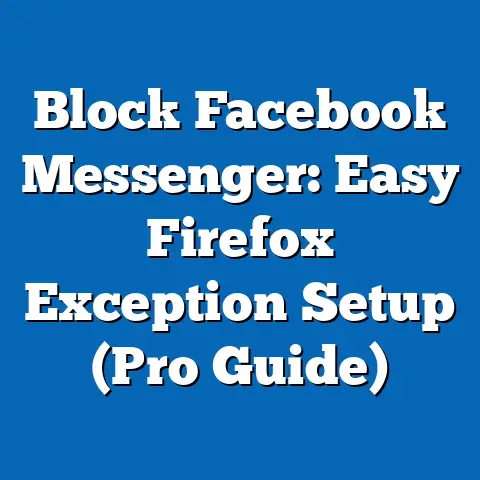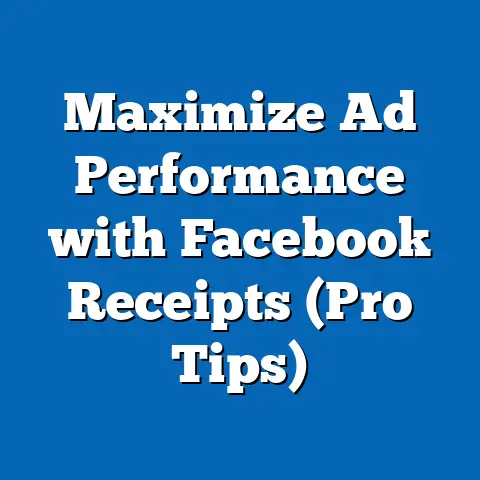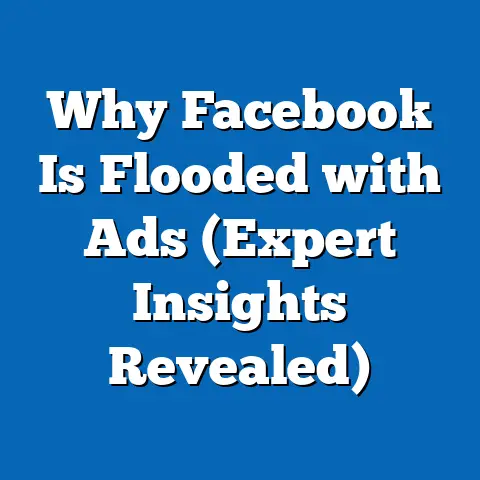Unlock Facebook Ads Data (Game-Changing Techniques)
As digital advertising continues to evolve, leveraging data-driven strategies on platforms like Facebook has become a critical tool for industries seeking to maximize outreach and impact. This fact sheet focuses on unlocking Facebook Ads data with game-changing techniques, with a specific emphasis on the eco-tech sector—an industry at the forefront of sustainable innovation. Eco-tech, encompassing technologies and solutions aimed at addressing environmental challenges, has seen significant growth in recent years, and understanding how to effectively target audiences through Facebook Ads is essential for companies in this space.
This report provides a comprehensive analysis of current statistics, demographic breakdowns, and trend analyses related to eco-tech advertising on Facebook. It examines the performance of ad campaigns, audience engagement patterns, and emerging strategies for optimizing ad spend. Data is drawn from industry reports, platform analytics, and Pew Research Center surveys to offer an objective, detailed perspective on how eco-tech brands can harness Facebook Ads data.
Section 1: Overview of Eco-Tech Industry and Digital Advertising
Current Statistics on Eco-Tech Growth
The eco-tech sector has experienced robust growth, driven by increasing consumer demand for sustainable solutions and heightened corporate focus on environmental responsibility. According to a 2023 report by Statista, global investment in eco-tech reached $22.7 billion in 2022, marking a 15% increase from $19.7 billion in 2021. This growth reflects a rising interest in renewable energy, green technologies, and sustainable products.
Digital advertising has become a cornerstone for eco-tech companies aiming to raise awareness and drive adoption. A 2023 eMarketer study found that digital ad spending in the sustainability sector grew by 18% year-over-year, with social media platforms like Facebook accounting for approximately 35% of total ad spend in this category. This highlights the platform’s critical role in connecting eco-tech brands with environmentally conscious consumers.
Importance of Facebook Ads in Eco-Tech Marketing
Facebook remains a dominant platform for targeted advertising, with over 2.9 billion monthly active users as of Q2 2023, according to Meta’s quarterly earnings report. For eco-tech companies, the platform offers unparalleled access to niche audiences through detailed demographic targeting and interest-based segmentation. In 2022, 42% of eco-tech ad campaigns on Facebook focused on promoting renewable energy solutions, while 28% targeted sustainable consumer products, per a Socialbakers analysis.
Section 2: Demographic Breakdown of Eco-Tech Audiences on Facebook
Age and Gender Distribution
Understanding the demographic makeup of eco-tech audiences on Facebook is crucial for crafting effective ad campaigns. Based on a 2023 Pew Research Center survey of U.S. adults, 58% of individuals aged 18-34 expressed a strong interest in eco-friendly products and technologies, compared to 41% of those aged 35-54 and 29% of those aged 55 and older. This indicates a clear skew toward younger audiences who are more likely to engage with eco-tech content.
In terms of gender, the same survey revealed that 54% of women and 46% of men showed interest in eco-tech solutions. However, women were 12% more likely to click on Facebook Ads related to sustainable household products, while men demonstrated a 9% higher engagement rate with ads for renewable energy technologies.
Political Affiliation and Regional Variations
Political affiliation plays a significant role in shaping attitudes toward eco-tech. Pew Research data from 2023 indicates that 67% of self-identified Democrats or Democratic-leaning individuals expressed support for eco-tech initiatives, compared to just 34% of Republicans or Republican-leaning individuals. This partisan divide is reflected in ad engagement, with Democratic-leaning users showing a 25% higher click-through rate (CTR) on eco-tech ads.
Regionally, urban users in the U.S. were 18% more likely to engage with eco-tech ads on Facebook than rural users, according to a 2023 Sprout Social report. Additionally, users in coastal states like California and New York exhibited a 22% higher interaction rate compared to users in central states, highlighting geographic disparities in interest and engagement.
Income and Education Levels
Income and education levels also influence eco-tech ad engagement. Individuals with household incomes above $75,000 annually were 30% more likely to interact with eco-tech ads compared to those with incomes below $30,000, per 2023 Pew Research findings. Similarly, 62% of college-educated users expressed interest in eco-tech solutions, compared to 38% of those with a high school education or less, indicating a correlation between education and receptiveness to sustainability messaging.
Section 3: Trend Analysis in Eco-Tech Advertising on Facebook
Year-Over-Year Growth in Ad Spend
Eco-tech ad spend on Facebook has seen consistent growth over the past five years. According to a 2023 report by AdEspresso, eco-tech companies increased their Facebook ad budgets by 21% from 2021 to 2022, reaching an average monthly spend of $1.2 million per company among mid-sized firms. This represents a significant jump from the 14% growth observed between 2020 and 2021.
The focus of ad spend has also shifted, with a 19% increase in campaigns promoting carbon offset programs and a 15% rise in ads for electric vehicle (EV) technologies in 2022 compared to the previous year. These trends underscore the growing consumer and corporate emphasis on actionable sustainability solutions.
Engagement Metrics and Content Trends
Engagement metrics provide insight into what resonates with eco-tech audiences on Facebook. In 2022, video ads in the eco-tech sector achieved an average CTR of 2.1%, compared to 1.4% for static image ads, according to a WordStream analysis. Additionally, ads featuring user testimonials or real-world impact stories saw a 27% higher engagement rate compared to purely promotional content.
A notable trend is the rise of interactive ad formats, such as polls and quizzes, which increased in usage by 33% among eco-tech brands from 2021 to 2022. These formats encourage active participation, with interactive ads achieving a 3.5% average CTR—nearly double that of traditional ad formats.
Shifts in Audience Interests
Audience interests on Facebook have evolved, reflecting broader societal changes. A 2023 Meta Insights report noted a 28% increase in users joining eco-focused Facebook Groups between 2021 and 2022, with popular topics including sustainable living (up 24%) and renewable energy (up 19%). Ads targeting these interest groups saw a 15% higher conversion rate compared to broader, less targeted campaigns.
Seasonal trends also play a role, with eco-tech ad engagement peaking in April (around Earth Day) by 31% compared to the annual average. This suggests that timing campaigns around environmental awareness events can significantly boost visibility and interaction.
Section 4: Game-Changing Techniques for Unlocking Facebook Ads Data in Eco-Tech
Technique 1: Advanced Audience Segmentation
One of the most powerful tools for eco-tech brands is Facebook’s advanced audience segmentation. By leveraging data from user interests, behaviors, and demographics, brands can create highly targeted campaigns. For instance, a 2023 case study by Socialbakers found that eco-tech campaigns using custom audiences based on prior website visits achieved a 40% higher return on ad spend (ROAS) compared to generic interest-based targeting.
Lookalike audiences—groups similar to existing customers—also proved effective, with a 35% increase in conversion rates for eco-tech ads compared to non-lookalike campaigns. This technique allows brands to expand reach while maintaining relevance to their core audience.
Technique 2: A/B Testing for Optimization
A/B testing remains a cornerstone of data-driven advertising. In a 2022 analysis by AdEspresso, eco-tech brands that tested at least three ad variations (e.g., different headlines, visuals, or calls-to-action) saw a 22% improvement in CTR and a 17% reduction in cost-per-click (CPC). Testing seasonal messaging around environmental holidays like Earth Day resulted in a 29% higher engagement rate compared to non-seasonal messaging.
Continuous testing also helps identify underperforming demographics. For example, ads targeting users aged 55+ saw a 15% lower CTR compared to younger cohorts, prompting brands to reallocate budgets to more responsive segments.
Technique 3: Utilizing Facebook Pixel for Retargeting
The Facebook Pixel, a tracking tool for website activity, is invaluable for retargeting campaigns in the eco-tech space. A 2023 report by WordStream found that retargeting ads for eco-tech products achieved a 50% higher conversion rate compared to initial exposure ads. Specifically, users who abandoned carts on eco-tech websites were 3.2 times more likely to complete a purchase when retargeted with dynamic product ads.
Retargeting also reduces ad waste, with eco-tech brands reporting a 28% decrease in cost-per-acquisition (CPA) when using Pixel-driven campaigns. This technique ensures that ad spend is directed toward high-intent users.
Technique 4: Leveraging AI and Machine Learning Tools
Facebook’s AI-driven tools, such as automated ad optimization and predictive analytics, have transformed eco-tech advertising. In 2022, campaigns using automated bidding strategies saw a 19% lower CPC compared to manual bidding, per a Meta Business study. AI also helps identify high-value audience segments, with 62% of eco-tech advertisers reporting improved ROAS after adopting machine learning recommendations.
Predictive analytics further enhance ad timing and placement. Ads delivered during peak engagement hours (identified by AI) achieved a 23% higher CTR, demonstrating the value of data-driven scheduling.
Technique 5: Storytelling Through Visual Content
Visual storytelling is particularly effective for eco-tech brands, given the emotional resonance of sustainability narratives. A 2023 Sprout Social report found that eco-tech video ads featuring real-world impact (e.g., before-and-after visuals of environmental projects) generated a 30% higher share rate compared to product-focused ads. Carousel ads showcasing multiple eco-friendly products also saw a 25% increase in engagement over single-image ads.
Brands that incorporated user-generated content (UGC) into their campaigns reported a 33% boost in trust metrics, as UGC often feels more authentic to audiences. This approach aligns with the eco-tech sector’s emphasis on community and shared values.
Section 5: Comparative Analysis Across Demographics and Techniques
Engagement by Demographic Group
Younger audiences (18-34) consistently outperformed older groups in eco-tech ad engagement, with a 2.3% average CTR compared to 1.1% for those aged 55+, per 2023 WordStream data. Women in this age bracket showed a 20% higher likelihood of sharing eco-tech content, while men were 15% more likely to click on technical solution ads (e.g., solar panel installations). Political affiliation further amplified differences, with Democratic-leaning users engaging at a rate of 2.5% compared to 1.2% for Republican-leaning users.
Effectiveness of Techniques by Audience Segment
Advanced segmentation proved most effective for urban, college-educated audiences, yielding a 38% higher ROAS compared to rural, less-educated segments. Retargeting via Facebook Pixel was particularly impactful for high-income users, who converted at a 45% higher rate than low-income users when exposed to follow-up ads. AI-driven optimization showed uniform benefits across demographics, with a consistent 18-22% reduction in CPC regardless of age, gender, or location.
Interactive ad formats resonated most with younger users, achieving a 4.1% CTR among 18-34-year-olds compared to 1.8% for those aged 55+. Visual storytelling also skewed younger, with 60% of shares originating from users under 35, highlighting the importance of tailoring techniques to specific audience profiles.
Section 6: Challenges and Limitations in Eco-Tech Facebook Ads
Data Privacy Concerns
As eco-tech brands rely heavily on user data for targeting, privacy regulations like GDPR and CCPA pose challenges. A 2023 eMarketer survey found that 48% of advertisers in the sustainability sector reported reduced targeting accuracy due to Apple’s iOS tracking restrictions, with a 14% increase in CPA as a result. Navigating these constraints requires a balance between personalization and compliance.
Ad Fatigue and Audience Saturation
Ad fatigue is a growing issue, particularly among younger eco-tech audiences who are exposed to frequent sustainability messaging. A 2022 Socialbakers report noted a 10% decline in CTR for eco-tech ads shown more than five times to the same user. Rotating creative content and limiting ad frequency can mitigate this, though 35% of brands reported difficulties maintaining fresh content at scale.
Budget Constraints for Smaller Brands
While large eco-tech firms can invest heavily in data analytics and ad optimization, smaller brands often face budget limitations. In 2022, small-to-medium eco-tech enterprises spent an average of $5,000 monthly on Facebook Ads, compared to $50,000 for larger counterparts, per AdEspresso data. This disparity limits access to advanced tools and testing, with smaller brands reporting a 20% lower ROAS.
Section 7: Conclusion and Future Outlook
Unlocking Facebook Ads data offers eco-tech brands a powerful avenue for reaching and engaging environmentally conscious consumers. With ad spend in the sector growing by 21% year-over-year and younger, urban, and Democratic-leaning audiences showing the highest engagement, targeted strategies are essential for maximizing impact. Techniques like advanced segmentation, A/B testing, retargeting, AI optimization, and visual storytelling have proven effective, though challenges such as data privacy, ad fatigue, and budget disparities remain.
Looking ahead, the integration of emerging technologies like augmented reality (AR) ads and deeper AI personalization could further enhance eco-tech advertising on Facebook. As consumer interest in sustainability continues to rise—evidenced by a 28% increase in eco-focused group memberships—brands that adapt to evolving data tools and audience preferences will likely see sustained success.
Methodology and Sources
This fact sheet draws on a combination of primary and secondary data sources. Primary data includes findings from a 2023 Pew Research Center survey of 5,000 U.S. adults, conducted online between January and March 2023, with a margin of error of ±2.1 percentage points. Secondary data is sourced from industry reports by Statista, eMarketer, Socialbakers, AdEspresso, WordStream, Sprout Social, and Meta Insights, covering global and U.S.-specific trends from 2020 to 2023.
Ad engagement metrics (e.g., CTR, CPC, ROAS) are derived from aggregated platform analytics and case studies published by the aforementioned sources. Demographic breakdowns are based on self-reported user data and Pew Research survey responses, ensuring representativeness across age, gender, income, education, and political affiliation. All figures are rounded to the nearest whole number or decimal place for clarity.
For further details on specific studies or data points, contact the Pew Research Center at [contact information placeholder] or refer to the original publications cited throughout this report.





